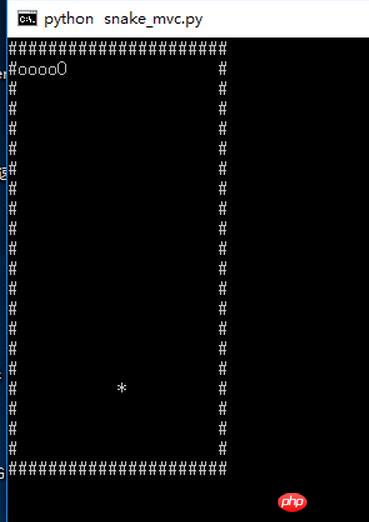这篇文章主要为大家详细介绍了Python贪吃蛇游戏的编写代码,具有一定的参考价值,感兴趣的小伙伴们可以参考一下
最近在学Python,想做点什么来练练手,命令行的贪吃蛇一般是C的练手项目,但是一时之间找不到别的,就先做个贪吃蛇来练练简单的语法。
由于Python监听键盘很麻烦,没有C语言的kbhit(),所以这条贪吃蛇不会自己动,运行效果如下:

要求:用#表示边框,用*表示食物,o表示蛇的身体,O表示蛇头,使用wsad来移动
Python版本:3.6.1
系统环境:Win10
类:
board:棋盘,也就是游戏区域
snake:贪吃蛇,通过记录身体每个点来记录蛇的状态
game:游戏类
本来还想要个food类的,但是food只需要一个坐标,和一个新建,所以干脆使用list来保存坐标,新建food放在game里面,从逻辑上也没有太大问题
源码:
# Write By Guobao
# 2017/4//7
#
# 贪吃蛇
# 用#做边界,*做食物,o做身体和头部
# python 3.6.1
import copy
import random
import os
import msvcrt
# the board class, used to put everything
class board:
__points =[]
def __init__(self):
self.__points.clear()
for i in range(22):
line = []
if i == 0 or i == 21:
for j in range(22):
line.append('#')
else:
line.append('#')
for j in range(20):
line.append(' ')
line.append('#')
self.__points.append(line)
def getPoint(self, location):
return self.__points[location[0]][location[1]]
def clear(self):
self.__points.clear()
for i in range(22):
line = []
if i == 0 or i == 21:
for j in range(22):
line.append('#')
else:
line.append('#')
for j in range(20):
line.append(' ')
line.append('#')
self.__points.append(line)
def put_snake(self, snake_locations):
# clear the board
self.clear()
# put the snake points
for x in snake_locations:
self.__points[x[0]][x[1]] = 'o'
# the head
x = snake_locations[len(snake_locations) - 1]
self.__points[x[0]][x[1]] = 'O'
def put_food(self, food_location):
self.__points[food_location[0]][food_location[1]] = '*'
def show(self):
os.system("cls")
for i in range(22):
for j in range(22):
print(self.__points[i][j], end='')
print()
# the snake class
class snake:
__points = []
def __init__(self):
for i in range(1, 6):
self.__points.append([1, i])
def getPoints(self):
return self.__points
# move to the next position
# give the next head
def move(self, next_head):
self.__points.pop(0)
self.__points.append(next_head)
# eat the food
# give the next head
def eat(self, next_head):
self.__points.append(next_head)
# calc the next state
# and return the direction
def next_head(self, direction='default'):
# need to change the value, so copy it
head = copy.deepcopy(self.__points[len(self.__points) - 1])
# calc the "default" direction
if direction == 'default':
neck = self.__points[len(self.__points) - 2]
if neck[0] > head[0]:
direction = 'up'
elif neck[0] < head[0]:
direction = 'down'
elif neck[1] > head[1]:
direction = 'left'
elif neck[1] < head[1]:
direction = 'right'
if direction == 'up':
head[0] = head[0] - 1
elif direction == 'down':
head[0] = head[0] + 1
elif direction == 'left':
head[1] = head[1] - 1
elif direction == 'right':
head[1] = head[1] + 1
return head
# the game
class game:
board = board()
snake = snake()
food = []
count = 0
def __init__(self):
self.new_food()
self.board.clear()
self.board.put_snake(self.snake.getPoints())
self.board.put_food(self.food)
def new_food(self):
while 1:
line = random.randint(1, 20)
column = random.randint(1, 20)
if self.board.getPoint([column, line]) == ' ':
self.food = [column, line]
return
def show(self):
self.board.clear()
self.board.put_snake(self.snake.getPoints())
self.board.put_food(self.food)
self.board.show()
def run(self):
self.board.show()
# the 'w a s d' are the directions
operation_dict = {b'w': 'up', b'W': 'up', b's': 'down', b'S': 'down', b'a': 'left', b'A': 'left', b'd': 'right', b'D': 'right'}
op = msvcrt.getch()
while op != b'q':
if op not in operation_dict:
op = msvcrt.getch()
else:
new_head = self.snake.next_head(operation_dict[op])
# get the food
if self.board.getPoint(new_head) == '*':
self.snake.eat(new_head)
self.count = self.count + 1
if self.count >= 15:
self.show()
print("Good Job")
break
else:
self.new_food()
self.show()
# 反向一Q日神仙
elif new_head == self.snake.getPoints()[len(self.snake.getPoints()) - 2]:
pass
# rush the wall
elif self.board.getPoint(new_head) == '#' or self.board.getPoint(new_head) == 'o':
print('GG')
break
# normal move
else:
self.snake.move(new_head)
self.show()
op = msvcrt.getch()
game().run()笔记:
1.Python 没有Switch case语句,可以利用dirt来实现
2.Python的=号是复制,复制引用,深复制需要使用copy的deepcopy()函数来实现
3.即使在成员函数内,也需要使用self来访问成员变量,这和C++、JAVA很不一样
以上是用Python写贪吃蛇游戏的代码实例的详细内容。更多信息请关注PHP中文网其他相关文章!
 Python vs.C:申请和用例Apr 12, 2025 am 12:01 AM
Python vs.C:申请和用例Apr 12, 2025 am 12:01 AMPython适合数据科学、Web开发和自动化任务,而C 适用于系统编程、游戏开发和嵌入式系统。 Python以简洁和强大的生态系统着称,C 则以高性能和底层控制能力闻名。
 2小时的Python计划:一种现实的方法Apr 11, 2025 am 12:04 AM
2小时的Python计划:一种现实的方法Apr 11, 2025 am 12:04 AM2小时内可以学会Python的基本编程概念和技能。1.学习变量和数据类型,2.掌握控制流(条件语句和循环),3.理解函数的定义和使用,4.通过简单示例和代码片段快速上手Python编程。
 Python:探索其主要应用程序Apr 10, 2025 am 09:41 AM
Python:探索其主要应用程序Apr 10, 2025 am 09:41 AMPython在web开发、数据科学、机器学习、自动化和脚本编写等领域有广泛应用。1)在web开发中,Django和Flask框架简化了开发过程。2)数据科学和机器学习领域,NumPy、Pandas、Scikit-learn和TensorFlow库提供了强大支持。3)自动化和脚本编写方面,Python适用于自动化测试和系统管理等任务。
 您可以在2小时内学到多少python?Apr 09, 2025 pm 04:33 PM
您可以在2小时内学到多少python?Apr 09, 2025 pm 04:33 PM两小时内可以学到Python的基础知识。1.学习变量和数据类型,2.掌握控制结构如if语句和循环,3.了解函数的定义和使用。这些将帮助你开始编写简单的Python程序。
 如何在10小时内通过项目和问题驱动的方式教计算机小白编程基础?Apr 02, 2025 am 07:18 AM
如何在10小时内通过项目和问题驱动的方式教计算机小白编程基础?Apr 02, 2025 am 07:18 AM如何在10小时内教计算机小白编程基础?如果你只有10个小时来教计算机小白一些编程知识,你会选择教些什么�...
 如何在使用 Fiddler Everywhere 进行中间人读取时避免被浏览器检测到?Apr 02, 2025 am 07:15 AM
如何在使用 Fiddler Everywhere 进行中间人读取时避免被浏览器检测到?Apr 02, 2025 am 07:15 AM使用FiddlerEverywhere进行中间人读取时如何避免被检测到当你使用FiddlerEverywhere...
 Python 3.6加载Pickle文件报错"__builtin__"模块未找到怎么办?Apr 02, 2025 am 07:12 AM
Python 3.6加载Pickle文件报错"__builtin__"模块未找到怎么办?Apr 02, 2025 am 07:12 AMPython3.6环境下加载Pickle文件报错:ModuleNotFoundError:Nomodulenamed...
 如何提高jieba分词在景区评论分析中的准确性?Apr 02, 2025 am 07:09 AM
如何提高jieba分词在景区评论分析中的准确性?Apr 02, 2025 am 07:09 AM如何解决jieba分词在景区评论分析中的问题?当我们在进行景区评论分析时,往往会使用jieba分词工具来处理文�...


热AI工具

Undresser.AI Undress
人工智能驱动的应用程序,用于创建逼真的裸体照片

AI Clothes Remover
用于从照片中去除衣服的在线人工智能工具。

Undress AI Tool
免费脱衣服图片

Clothoff.io
AI脱衣机

AI Hentai Generator
免费生成ai无尽的。

热门文章

热工具

SublimeText3 Mac版
神级代码编辑软件(SublimeText3)

记事本++7.3.1
好用且免费的代码编辑器

MinGW - 适用于 Windows 的极简 GNU
这个项目正在迁移到osdn.net/projects/mingw的过程中,你可以继续在那里关注我们。MinGW:GNU编译器集合(GCC)的本地Windows移植版本,可自由分发的导入库和用于构建本地Windows应用程序的头文件;包括对MSVC运行时的扩展,以支持C99功能。MinGW的所有软件都可以在64位Windows平台上运行。

EditPlus 中文破解版
体积小,语法高亮,不支持代码提示功能

SublimeText3 Linux新版
SublimeText3 Linux最新版





